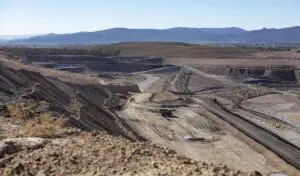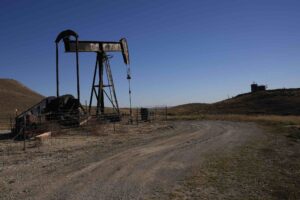There is uproar in Coober Pedy, the iconic mining town deep in the South Australian desert that is known as the Opal Capital of the world.
What should have been a positive story about a project to shift the town from diesel to a renewable-focused mini-grid based around wind and solar and storage is causing outrage among consumers and councillors, and embarrassment to the developer and the federal agency that backed it.
Last year, as we reported at the time, the final plan for the Coober Pedy Renewable Diesel Hybrid project was unveiled, featuring 4MW of wind, 1MW of solar and a 1MW/250kWh battery to provide up to 70 per cent of the power needs of Coober Pedy.
The idea was that it would dramatically reduce the amount of diesel consumed from the existing 3.9MW diesel power station, reduce costs, and provide a possible blueprint for the rest of Australia to follow.
But what should have been a flagship project for the country – as ARENA CEO Ivor Frischknecht touted it at the time – looks like turning into a disaster for the town and an embarrassment for the renewable energy industry; and a legal dispute between the council and the developers.
It has now emerged that the cost that will be charged to the council, which owns the local grid, and which will subsidised by the government, will be more than double other alternatives.
Graham Davies, from Adelaide-based Resonant Solutions, who completed an assessment on behalf of council last year, says that the average cost of generating electricity, not including distribution but including rebates, will be 48c/kWh.
The deal signed by council will translate to total cost of $192 million over 20 years, a saving of a dismal $5 million over the diesel only grid staying as is for 20 years – which would simply not happen.
The company’s own presentation on the project, made last May, appears to confirm that there is little difference between the ongoing cost of diesel and the solar, wind and storage grid. (see graph below). Renewable energy experts say that is absurd.
Davies says the PPA is more than twice the average price (23c/kWh) suggested by three rival quotes that he sought from other developers. In 20 years, the price to council will be more than $1/kWh. Solar and wind costs by that stage are expected to be just a few cents per kilowatt-hour.
And he wonders why a tender was not sought. “We agree with …. that hybrid renewable energy is the most affordable and reliable way to produce electricity in Coober Pedy over the long term, however the issue is that with a tender we believe prices could have been roughly half,” Davies said.
It has led to the extraordinary situation where some homes and some the big business in a population of 3,500 are threatening to go “off grid” – in a town that is already off the grid – because they reason, quite rightly, that they can use their own solar and storage to provide electricity at a fraction of the cost.
Indeed, the independent assessment from Resonant Solutions suggests that 40 to 80 per cent of the town’s customers would quit the local grid if the contract continues as is – leading to a death spiral because the council is lumbered with a fixed cost, no matter how much is used.
Resonant Solutions questions the technology choices made by EDL, the costings, and some of the contract details, such as a limit on rooftop solar in the town, effectively removing competition from the “centralised” generation.
There are certainly big questions to be asked about how EDL – in its first significant push into wind and solar technologies – got its numbers and its technology calculations so wrong. It has been the supplier of the diesel generators to the Coober Pedy grid since 2004.
And there are also questions about why the Australian Renewable Energy Agency agreed to fund it – to the tune of $18.4 million – and why the South Australian government agreed on the power purchase agreement with EDL.
But it also highlights what can go wrong when decisions are made on the basis of questionable modelling.
In many ways, it serves as a proxy of what is happening now in the broader National Energy Market, where most of the modelling provided to policy makers gets cost of technologies – particularly wind and solar and storage – hopelessly wrong. And bad decisions are made because of it – mostly propping up incumbent and increasingly expensive fossil fuel technologies.
Coober Pedy councillors describe the situation as a shame, even if there appears to be little they can do about it, seeing that the PPA has been signed, the two wind turbines have already been installed, and the solar farm is also in place, and only the “enabling” technologies – battery storage and smart controls – wait to be connected.
“If this was done properly, there is a good chance that we wouldn’t need the state subsidy,” says councillor Justin Freytag, who was elected to council last year, three months after the contract was signed.
“And that would have been fantastic. But now we are lumbered with this. We’re trying to get state government, and ARENA and EDL to the table, but it’s like herding cats.”
In its damming report, Resonant Solutions says the deal is significantly more expensive than other available commercial options, and – even with a government subsidy that guarantees locals don’t pay more than people in Adelaide – could lead to grid defection within 5-10 years and a doubling of the kWh rate.
“Resonant considers the proposal to be exceedingly expensive, highly risky to (the Coober Pedy Council) and damaging to the renewable energy reputation,” the consultant said in a report completed early last year for the council.
The report by Resonant suggests that poor decisions have been made about technologies, particularly the various “smarts” used to integrate wind, solar, storage and diesel. It also suggests EDL will be getting an “excessive” internal rate of return.
It also questions why the developers would put a limit (100kW) on the total amount of rooftop solar within the grid, when it would make better sense to encourage it.
It says up to 400kW would directly displace diesel, and the payback on that extra rooftop solar investment is estimated at 1.5 years.
So what happens now? Two major businesses, including the Desert Cave Hotel and the Opal Inn, and the operator of the local IGA supermarket, have told local news website InDaily that they are looking to manage their own electricity needs.
“I think they walked in there with their eyes shut and their arse exposed,” Desert Cave Hotel owner Robert Coro told the InDaily website, regarding the decision to sign the PPA.
“It’s going to hurt our town,” councillor Freytag told RenewEconomy. “It’s an opportunity missed to get cost competitive renewables.”
Note: ARENA said it had no comment on the Coober Pedy project. We also sought comment from EDL, but did not receive a reply before publication. EDL’s presentation last May to the local community is here. Interestingly, among the benefits cited by the company, lower electricity costs is not one of them.
On its website, it does say, however, that “this project is expected to provide a lower and more stable cost of electricity over the project life for the District Council of Coober Pedy and the South Australian Government.”













